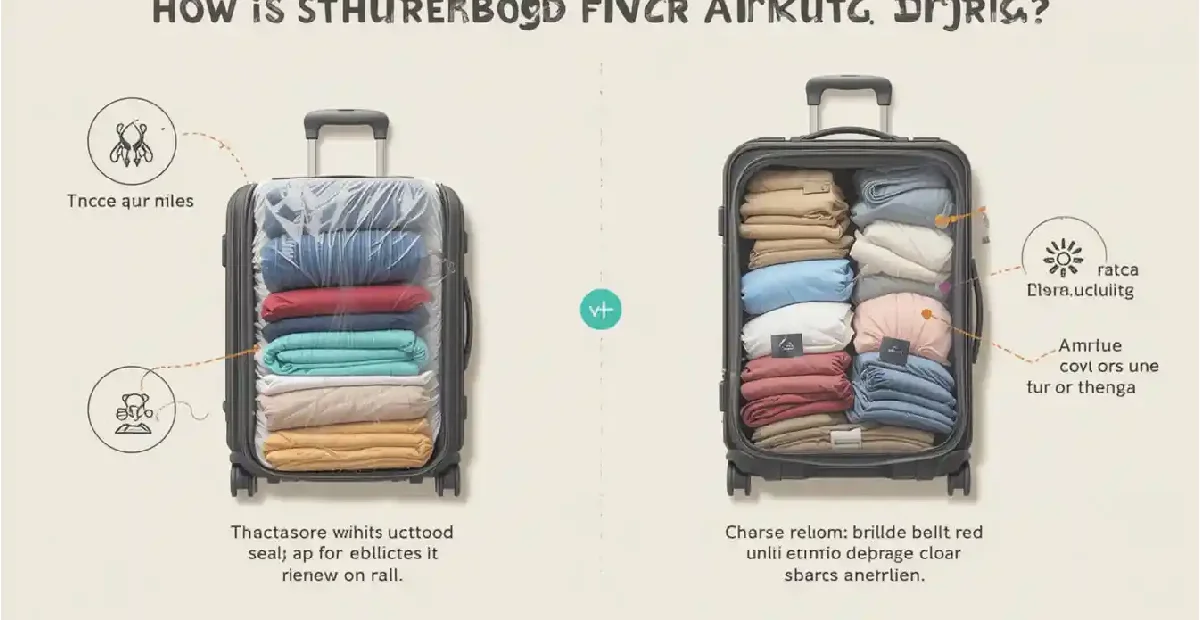Learn how compression packing bags work? The key to maximizing your suitcase space and packing smarter for your next trip!
We all know what it is like to stare at a suitcase that refuses to zip no matter how firmly, forcefully, and hard you sit on it. The first question that pops in mind is how do compression packing bags work. Whether you’re a newbie tourist or a frequent flier, the dilemma of overpacking is a perennial problem for all travelers. Inevitably, you all need just a little more room than your luggage can accommodate.
Cue compression packing bags — a genius way to create space without the hassle. These bags are handy for sucking up air out of your clothes and such to have more space for more important things to be organized.
So how does it work, a compression packing bag? You’ll have seen them in stores or heard them extolled by other travelers, the real brilliance unfolds when you realize how they work to reduce suitcase volume. In this article, we will explore the reasons behind their effectiveness and popularity, even amongst those who are just off on a weekend trip or an international trial of overpacking, and the benefits they can bring to your own packing.
Want to find out more about this? Check out Do Compression Packing Cubes Wrinkle Clothes
What Are Compression Packing Bags?
Compression packing bags are a type of packing aids that allow you to pack more into your luggage by reducing the bulk of soft items such as clothes. These bags function to extract any excess air, either through a simple vacuum seal, or even just by rolling them, as it shrinkify your things down to a more portable size. The result? No need of extra bags → More room in your suitcase
Why They’re Popular
Compression packing bags have become an essential travel accessory for travelers whether you are packing for your family, a business trip, or a backpacking trip. Just think about it, being able to fit your entire week worth of clothes in a carry-on or having space for souvenirs coming back. They are the perfect travel solution to wrangling all that excess, too, ensuring maximum space usage in luggage and zero wrinkles, ideal for anyone from occasional travelers to nomads on the grind.
Compression packing bags are the answer to the question of what if you have to bring some, or all, of the contents of your suitcase with you, but it is too full to close. If you have ever stood on a suitcase to zip it shut, or thought you might have packed beyond your weight limit, compression packing bags are for you.
The Science Behind Compression Bags
So, how do compression packing bags work? It’s actually pretty simple once you understand the science behind it.
These bags rely on getting all the air that gets trapped between your clothes out, which is what makes them so puffy to begin with. It’s similar to a food storage bag where you see when you suck the air out of the bag the food occupies much less space in the fridge. The same concept applies to your packing. This minimizes the air in the bags, allowing you to maximize the items you can fit in your luggage.
There are vacuum-sealed and roll-up compression bags. Using vacuum-sealed bags, you either use a tiny pump or your at-home vacuum to suck the air out, packing your clothes tightly together. The roll-up bags are great for travel but not ideal for everyday use. Normally you roll them up and the air squeezes out through a one-way valve as you do, compressing your stuff.
Everyday Analogy
Imagine blowing up a balloon. It occupies a large volume when it’s inflated with air. However, when you deflate the balloon, it shrinks and becomes flat. It works just like you would imagine with your clothes by removing the air so you’re left only with fabric instead of air that was inflating it.
Once you get this elementary science, you can see why those compression packing bags have such an impact on your bag. Like a smarter, not harder way to pack!
For a full breakdown, check out Are Compression Packing Cubes Worth It
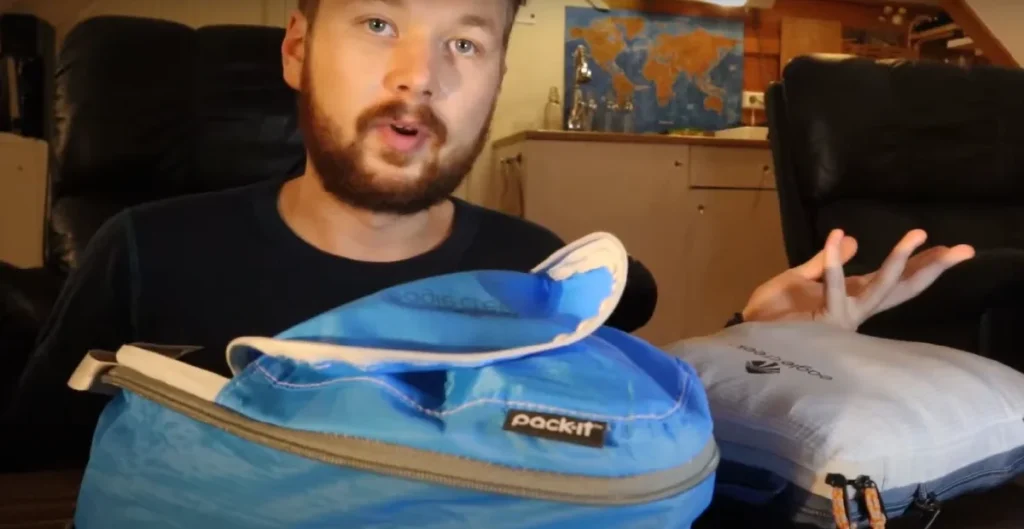
Step-by-Step: How to Use Compression Packing Bags
Compression packing bags are simple to use and can make a world of difference in packing. So without further ado, here is a breakdown of how to use a vacuum sealer with easy to follow tips by hand and vacuum bags.
For Manual Bags
Pick Your Stuff: Pick the clothes or soft items you’d like to take with you. Natural fabrics are ideal (think light, airy materials).
Open the Bag Fully unzip the compression bag.
- Load Up Your Stuff: Take your garments and stack all of them accordingly at the pocket pouch; Do not overstuff, as this can cause the bag from sealing correctly.
- Zip The Bag: Zip up the bag, ensure the zipper is in the fully closed position.
- Get out the air by Rolling: Beginning with one side, roll the pack firmly towards the zipper. This pushes out more air while you roll.
- Reseal: After you’ve pressed out as much air as you can, zip up the top of the bag to make sure it is secure.
When packing, always have a little wiggle room at the top of the bag for more compression. Pro-Tip.
For Vacuum Bags
- Select Your Items: As you do with manual bags pick a soft items you want to pack.
- Part the Bag: Unzip the vacuum packing bag and particle to in.
- Packing your stuff: Lay your clothes Flat in the Bag. However be careful not to overfill, since that might impact the vacuum seal.
- Banish the Zipper: Close up the zipper tight and dig the wig out of the zipper.
- Utilize the Vacuum: Use your vacuum to suck the air out. Ensure that the nozzle is securely attached to the bag valve.
- Close the Valve: After you’ve trapped the air in this way, close the valve so that the vacuum isn’t lost.
- NOTE: Before traveling make sure your vacuum is sealed! Pro-Tip!
Common Mistakes to Avoid
- Filling Pack Bags Too Full: This may result in inadequate closure and reduced compression capability.
- Not Checking the Zip: Make sure to check the zip and ensure it is fully closed so no air is re-entering.
Visual Aids
Use infographics or images to back these infographics. Because this is very clear and easy to write, some simple diagrams indicating the process for both manual and vacuum bags would make this point, so much more easily and it would improve the engagement of the readers. Images allow a quick understanding of concepts and likely improve the reader experience.
Now with these 4 easy steps you will be prepared to use Compression packing bags in your suitcase to compress the staying space to the maximum!
For expert tips, visit How Do Compression Packing Bags Work for Travel
Types of Compression Packing Bags
There are mainly two types of compression packing bags — Manual Compression Bags and Vacuum Compression Bags. They both provide unique opportunities and most ideal for different use-cases that affect which packaging you will choose. Let’s compare the two.
Manual Compression Bags
- Update: Hand-compression bags are rolled or pressed to remove air. They do not need any external equipment, and they are generally less heavy and easier to pack.
- When to Pack: These bags are perfect for fast trips or road journeys where you will need to unpack and pack a lot. Also ideal for minimalist travelers, they provide a no-fuss pragmatic alternative that requires no additional implements.
Pros:
- No need for a vacuum or pump
- Lightweight and easy to use
- Affordable and widely available
Cons:
- May not compress items as tightly as vacuum bags
- Requires manual effort to remove air
- Vacuum Compression Bags
- Vacuum compression bags: These bags utilize a vacuum cleaner to whisk away the air, sealing your items very firmly in the bag. They usually contain a one way valve that will help to hold the vacuum seal.
- When To Use: Best used for longer trips or for packing bulkier items such as jackets or bedding. They come in especially handy for seasonal clothes or items you know you won’t use for a while.
Pros:
- Achieves maximum compression, saving the most space
- Keeps items protected from moisture and pests
- Ideal for bulkier items
Cons:
- Requires access to a vacuum cleaner
- Slightly heavier due to the thicker material
- Can be more expensive than manual options
Quick Decision-Making
Select Manual Compression Bags if you need a lightweight, user friendly option for a short trip or you just don’t want to lug additional gear with you.
Choose Vacuum Compression Bags if you are going on a long journey, need to pack bulky items, or want the best space-efficient packers in the world.
When it comes to travel accessories such as compression packing bags, it is important to know the difference, so you can choose according to your travels. So whether you want to know how compression packing bags work or just want to pack smarter, picking out th
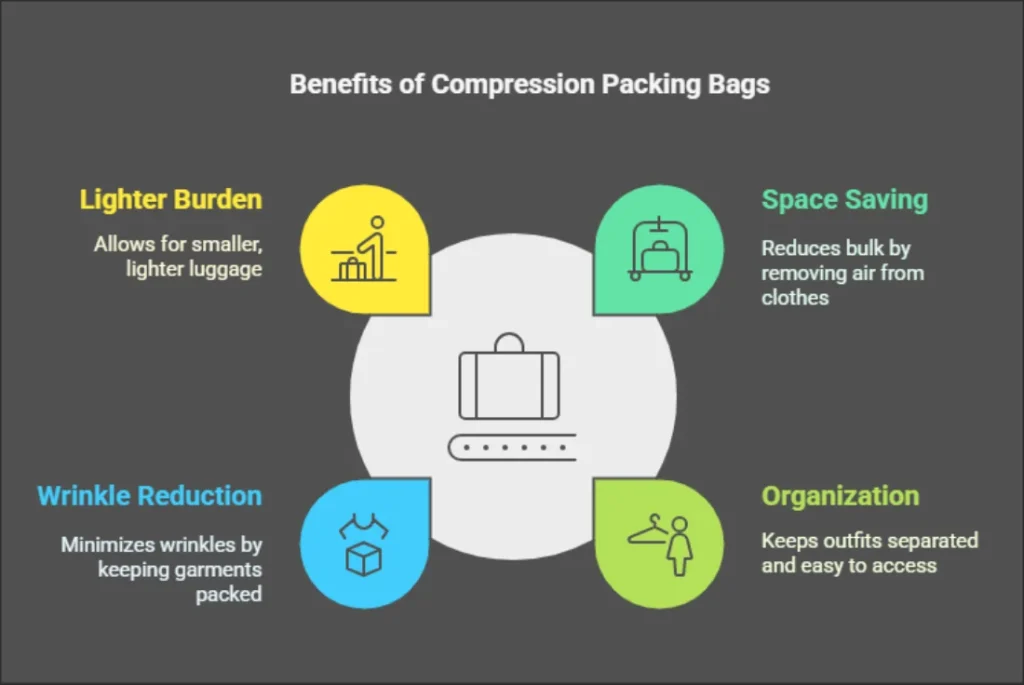
Benefits of Compression Packing Bags
The benefits of using compression packing bags can make your traveling less stressful and a lot more fun. These bags are already offering some instant return on investment for travelers — here are some quick wins.
- Space saver: These bags reduce the bulk of your clothing by removing the excess air, which means you can pack way more clothes into your suitcase! Compression bags let you do things like pack winter clothes or bulky jackets into a carry-on!
- Stay organized: Compression bags are a great way to keep your clothes from getting lost. Outfits can be separated by day or type (casual, business, etc.) making it simple to find the outfit you need without rifling through a pile of clothes in your suitcase.
- Minimize Wrinkles: These bags can help reduce wrinkles by keeping your garments well packed. You definitely do not want to take out your shirt right before an important meeting only to find it all wrinkled!
- Reducing Your Burden: When you can fit more into less you can travel with smaller sized luggage, which makes it a little easier when struggling through the airport or train station. It also usually translates to lighter bags, ideal for avoiding excess baggage fees.
While useful for travel, compression bags have a lot of versatility. Plus, if you’re sick of clothes piled everywhere — they’re ideal for seasonal storage to keep everything in order and protected until you need your wardrobes again.
Relatable Anecdotes
- Imagine this: You are preparing for a week-long ski journey and your suitcase is stuffed to the gills with thick sweaters, thermal underlayers, and oversized coats. Compression packing bags allow you to literally downsize everything to a fraction of its original size, leaving you with enough space for souvenirs on the way back home.
Think about a traveling business executive who must carry several briefs to attend meetings in a few cities. With compression bags, they keep each outfit organized, so they can grab whatever they need without needing to unpack everything!
You get to not only save more room in your luggage while organizing your items, but you also get the benefit of making travel a more pleasant experience with a little less stress on every trip and a little more pleasure.
Have you ever wondered about 20kg Suitcase Size in cm
Downsides to Consider
Although there are many benefits to travel compression packing bags, it is important to recognize three, in particular, that travelers may face. With these pain points, it lets you decide when to use compression bags wisely.
Common Frustrations
- Clothes can get wrinkled: The most common complaint is that when compressing clothes, they can end up wrinkled how we fold them. When you have to tint for meetings or occasions right after landing in your area, that could be overly troublesome.
- Not for everything: Compression bags are ideal for soft items. For stiff, structured garments such as a blazer, they might not compress well and end up being damaged.
- Sealing Problems: This also comes with the caveat of travelers having difficulty properly sealing manual bags, allowing air back in and decreasing the compression effectiveness.
Practical Solutions
Keep Wrinkles to A Minimum: In using compression packing bags to keep wrinkling to a minimum, you can try the following fold techniques:
- Fold Your Clothes Top To Bottom: Here are two techniques for packing your clothes tighter in a suitcase. This not only saves space, but also reduces creases.
- Utilize tissue paper: Add some layers of tissue paper in between pieces of clothing to help reduce creases. The tissue paper makes for a buffer that can iron out any wrinkles.
- Pack the Right Items: Avoid packing structured items such as blazers or dresses that will compress. Otherwise, pack it separately or use a travel-friendly garment bag made specifically for formal wear.
- Seal the Bag Well: If you are using the manual compression bags, roll the bag only when the zipper is closed completely. When you are using vacuum bags, make sure to pump all air out of it and close the valve very tightly.
If you are conscious of these disadvantages, and make sensible adjustments, you will minimize the frustrations associated with using compression packing bags, and enjoy all the benefits they bring. So if you know about how compression packing bags work and not to expect them to work miracles, you will maximize the experience.
Best Items to Pack in Compression Bags
Compression packing bags are great for packing away everything in the smallest area possible and also for organizing your luggage. But understanding what to include in these bags can improve your packing ability. Below is a rundown of the best things to pack in compression bags and what you should avoid.
Top Items to Pack
- Jackets: Big winter jackets and heavy coats will not take you far without hurdles in many ways at the luggage space. They can be packed down into like next to nothing with compression bags, which makes it so much easier to squeeze into your suitcase.
- Sweaters & Hoodies: Compression is the best option to utilize space for large items like winter cardigans, thick sweaters, and hoodies. If you roll them up really well before putting them in the bag, you should get them super squashed down.
- Bedding: Compression bags are great for packing bedding items, like comforters and blankets, especially for camping or extended holidays.
- Seasonal clothes: If you are flying to such a place where the climate will be varying, putting seasonal clothes in compression bags will help you to save space (like summer clothes, dresses, thermals, etc.).
- Towels: Towels, particularly big bath towels, are bulky. So by compressing them, you can fit in more items without expanding your luggage.
- Compression Sports Gear: Things such as workout clothes or active wear can all be pumped down and then packed into small bundles—this enables you to bring more active wear without retaining more space.
What Not to Pack
Compression packing bags are some of the most useful packing bags available, but certain items don’t do well being compressed:
- Fragile Materials: Compression bags can crush delicate items like silk or lace and wrinkles them easily. It is recommended that you keep these items packed separately.
- Clothes That Have Shape: Avoid blazers, suits, and dresses since they will lose their shape. If you do have to pack these, use a garment bag instead.
- Highly Embellished Clothes – Any clothing with sequins, beads, etc., can be damaged by compression. These should be packed carefully with separation.
- Delicate Items: Fragile Items should never be packed in a compression bag — think shoes or some electronic device; compression bags are famous for saving space, but when unfilled, can expose your items to the elements while traveling.
- Nasty Stuff: Do not pack damp or wet clothes into compression bags. It can cause mold and smell. Thus, guarantee your things are totally dry before pressing.
If you are aware of what to put in compression bags and what not to pack, you will be able to pack them to the fullest. Knowing this information means you will travel lighter and more organized on your next adventure as you now know how do compression packing bags work!
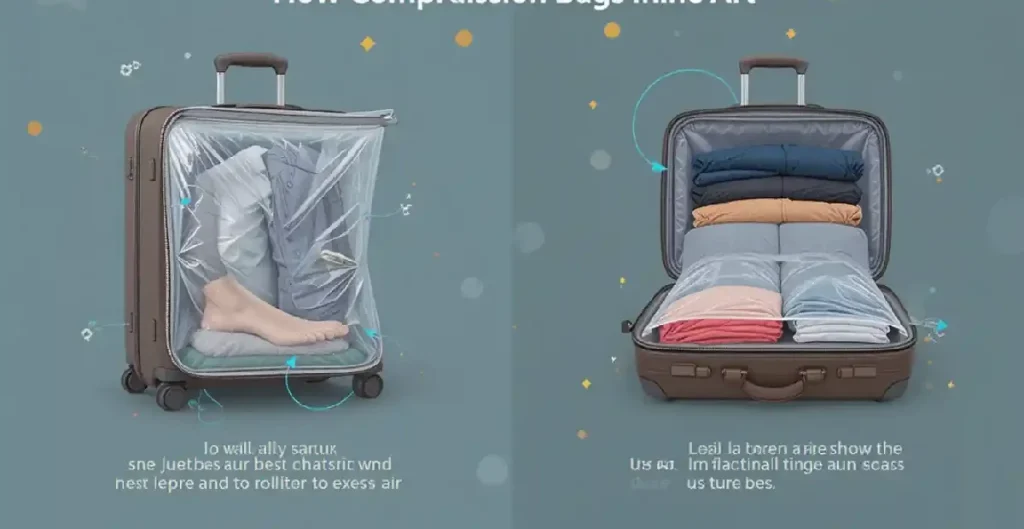
Compression Packing Bags vs. Other Packing Methods
There are a range of ways to pack your luggage, each providing a different advantage when it comes to the organization of your travel items. If you’re curious how compression packing bags compare with other popular packing methods such as packing cubes and rolling clothes, we’ve got the lowdown to help you choose which method is right for your travel needs. The following is a side-by-side comparison that summarizes the main characteristics of each.
| Method | Overview | Tools Needed | Step-by-Step Instructions | Considerations |
|---|---|---|---|---|
| 1. Check Default Combinations | TSA locks often have common default combinations. | None | 1. Try common combinations like 000, 123, or 999. | May work if you haven’t changed the combination. |
| 2. Contact the Manufacturer | Reach out to the lock’s manufacturer for guidance. | Phone/Email | 1. Locate customer service contact on the manufacturer’s website.2. Provide lock details to receive help. | They may provide guidance or reset options. |
| 3. Utilize the TSA Master Key | TSA agents have master keys for unlocking locks. | None (TSA Agent Only) | 1. If at an airport, request TSA assistance.2. Show identification and explain the situation. | Only TSA personnel can use master keys. |
| 4. Perform a Sound Test | Use sound to find the combination through tactile feedback. | Listening skills | 1. While turning the dials, listen for clicks at different settings.2. Keep track of potential combinations. | Requires patience and a good ear; may not be effective. |
| 5. Shim the Lock | Insert a shim to disengage the locking mechanism. | Shim (can be made from thin metal) | 1. Insert the shim between the lock body and the shackle.2. Apply gentle pressure while manipulating the shim. | Skill required; can be risky for damage if done incorrectly. |
| 6. Seek Professional Locksmith Help | Hire a locksmith to unlock the TSA007 lock. | None | 1. Find a certified locksmith.2. Explain the issue for them to assess and unlock the lock safely. | Cost involved; ensure they are experienced with TSA locks. |
| 7. Use a DIY Combination Decoder | Create a makeshift decoder tool to find the combination. | Paperclip or thin metal | 1. Straighten the paperclip to form a hook.2. Carefully insert it into the lock to feel for the pins.3. Rotate to identify pin positions. | Risk of damaging the lock; not always successful. |
| 8. Drilling as a Last Resort | Physically destroy the lock to gain access. | Drill and drill bits | 1. Mark the center of the lock.2. Carefully drill until the locking mechanism is broken.3. Remove the remains. | Permanent damage; replace lock necessary; costly. |
When to Choose Compression Packing Bags
- For Bulky Items: If you’re packing winter gear or bedding, compression bags are your perfect bet for maximizing space.
- Long Trips: For extended travel where you require to fit a variety of clothing, these bags allow you to condense your essentials effectively.
- Space Constraints: When traveling with limited luggage space, compression bags help you fit more items without exceeding weight limits.
Key Takeaway, While packing cubes and rolling clothes have their merits, compression packing bags shine when it comes to maximizing space for bulky items. By understanding how do compression packing bags work in comparison to other methods, you can select the right packing strategy for your next adventure, ensuring a more organized and efficient travel experience.
How to Avoid Overpacking with Compression Bags
Particularly useful for travelers, compression packing bags come with a bit of a psychological trap on the other end — the temptation to overpack. Having extra room to pack stuff into your luggage can also lead to unwanted overflow, limiting the enjoyment of your travels. Here are some tips to help you pack with intention and avoid the most common mistakes travelers make when overpacking.
Understanding the Psychological Trap
It is very tempting to believe that when you can use compression bags to cram your clothing to take even less space than it already does, you can always pack more than you need. Some of this can lead to luggage being heavy making it cumbersome and stressful while traveling. And, of course, just because you could cram more in your bags doesn’t mean you should.
Mindful Packing Tips
Establish a Packing Limit: Your packing limit should be assigned before you begin packing as to how many pieces of clothing you truly need for your trip. So that can help you limit what you pack. For instance, allow yourself three pairs of pants or five shirts—whatever it may be—no matter how many you can fit into your compression bags.
Pack What You Only Actually Need: You’re at your destination, Focus on packing what you need only. Think about what you will be doing and pack items that can mix and match. Choose multipurpose items to maximize versatility.
Implement a Packing List: Prior to packing, have a detailed packing list prepared. An important tip is to have a checklist that allows you to stay on track so you do not start adding impulsive items to the cart. Pack your compression bags with what you see on the list.
Planning Your Outfits: Plan your outfits for every one of your days of travel instead of adding random items into your suitcase. This method should reduce your need to pack things “just in case,” making it easier to visually see what you will need.
Evaluate What You Stuff: Before sealing your compression bags, be sure to evaluate what you have stuffed inside. Question yourself whether or not each item is really that essential. If there’s no it, take it out before the bags are sealed, so as not to have overloading.
Check the Bag Size: Take a look at your compression bags once packed. If they are looking a bit sucked dry, maybe it’s time to reconsider your options. Simply stuffing the bags can lead to a lot of unnecessary items.
Using compression packing bags can be truly advantageous but if you are not careful, you will end up making one of the biggest mistakes while packing, that is, over packing. So, to enjoy the benefits of compression packing bags, you will need to practice mindful packing. It means you can travel lighter and more efficiently, affirming that you are taking only what you need. With this knowledge of how do compression packing bags work, as well as with these tips up your sleeve, you will pack strategically, allowing for a more efficient and pleasant travel experience!
Real-World Reviews and Testimonials
It also solves one of the elements that makes a travel experience a little bit messy: travel packing bags that have become so popular to save space. So to prove how well these bags work, here are some reviews and testimonials from longtime travelers and authoritative sources who have actually found success with them.
User Reviews
1. Jessica L., Business Traveler
“Even though I travel for work often, and compression packing bags are the only way I manage to keep luggage in control. I can pack a whole week’s worth of clothing into my carry on! I really really love how I can do away with wrinkles and displace my blazers and dresses to make everything fit better. It relieves my trips from unnecessary tension and organization.”
2. Mark T., Family Vacationer
“We went on a Europe trip with the entire family. We managed to fit all of our kids clothes into a suitcase. I even fit their winter coats without making things bulky. The kids really loved the extra space for snacks and toys in the car!”
3. Samantha R., Backpacker
“As a backpacker, every square inch counts. For my bulkier items (jackets, sleeping bags, etc.) I used compression bags, and this helped so much. I would definitely recommend them to anyone who is wanting to conserve space and lighten the load of their pack. Just don remember not to overpack! ”
4. Daniel K., Weekend Traveler
“Packing for short trips used to be my nightmare because I could never fit everything in my bag. Then I discovered the wonders of compression packing bags. I can easily fit in a few outfits and even some toiletries. And also, they help in making everything systematic. For me, it completely changes the weekend getaway game!”
5. Lisa H., Travel Blogger
Compression packing bags are a must for anybody who is traveling light. They do what they say,save a lot of space, and I have tried a couple of brands! Just be careful with the instructions to not make your clothes turn out crumpled. For tourists I usually have these in my blogs where I share packing tips– I even made a note here, these bags are always on top of my list!
Practical Experiences
Featured Success: A few mates heading to a music festival wrote in to say that thanks to compression bags they could fit all their camping gear, clothes and essentials in their car, resulting in a much more enjoyable drive. They loved being able to feel organized and finding what they needed so easily without digging through stacks of stuff.
Top Travel Gear: ” Travel + Leisure magazine touted compression packing bags as “real space-savers” that are “so simple to use—just roll to compress and stuff.” These bags are particularly perfect for travelers who want to utilize every inch of packing space possible without chaos.
These reviews and success stories point out that compression packing bags are effective for many styles and types of travel. While you evaluate your choices, be aware that taking the user experiences on board lends authenticity to your overall decision-making process. Realization of this actual working of compression packing bags will lead you to make your trip more effective and enjoyably.
Care and Maintenance Tips
Care and maintenance will increase the availability of your compression packing bags for many trips ahead. A few simple (but practical) tips for cleaning, storing and caring for your bags, plus answers to common bag issues.
Cleaning Compression Packing Bags
1. Clean them regularly: Wipe your compression bags down with a damp cloth after every trip to get rid of dirt or debris. More thorough cleaning can be done by hand washing in cold water and mild soap. Avoid the use of strong detergents, as they can damage the material.
2. Allow the bags to air dry thoroughly before putting them away. Avoid prolonged exposure under direct sunlight which causes the material to degrade in a long-term process. To control their shape, dry them flat or hang them.
Storing Compression Packing Bags
Store Them Dry: ensure all of the bags are fully dry before you put them away to avoid mildew or mold. Keep it in a dry and cool place away from direct sunlight.
Keep CV Tidy: Do not overcrowd and store your bags in a confined area that could leave creases/dents. Instead, store them folded or loosely rolled in a way that the elastic wonce be destroyed.
Maintenance Tips
- Inspect Seals: Take the time to check your compression bags for signs of wear and tear. Replace it if you see damage, cracks or tears.
- Sealing Problem Solving: If your bag isn’t sealing, make sure that the zipper or closure is clean and debris-free. Wipe around the seal area and attempt to reseal, and check if that rectified the concern. If the issue continues, try applying some silicone lube to glide the zipper along easier.
- Don’t Overpack: Do not overstuff your compression bags if you want them to last longer. It helps avoid the damage of these bags as well as proper compression. To keep the bag strong, not comply with recommended weight limits.
With these care and maintenance tips, you ensure that you get the most out of your compression packing bags, they will always be there to slowly but surely pack your travel luggage. If you pay attention your bags will keep packing for you and will make travel smoother and organized. How do compression packing bags work in tandem with these maintenance practices will enhance their effectiveness and improve your complete travel experience.
Top Brands and Recommendations
There are plenty of reputable brands available when it comes to compression packing bags with their durability, ease of use, and functionality. So, here is a brief overview of the best brands and a purchasing guide to assist you select wisely.
1. SpaceSaver
- Summary: SpaceSaver bags are affordable and work great, and come in a variety of styles & sizes, including both manual and vacuum styles.
- Why They Caught Our Eye: Made out of durable material that promises longevity and double-zip design for leak-proof compression.
2. AmazonBasics
- AmazonBasics: goes for the economic approach while still maintaining quality. Compression bags: clean and simple, that is.
- Why You Will Love Them: These are relatively easy to use, so they work well for travelers of all experience levels. And for the most part they come in multipacks, so you get bang for your buck.
3. Travel Space Saver
- Brand: Travel gear brand specializes in quality, lightweight yet durable compression bags
- What Makes Them Unique: Its unique design helps to extract the maximum amount of air, they are easy to pack and unpack. A lot of users love their transparency, they are also easy to see.
4. Ziploc
- Of all the brands on the list: Ziploc is primarily known for its food storage products.
- What Sets Them Apart: You know what you are getting with gladness. The trusted seal on the bags prevents leaks, and they are perfect for travel or organizing stuff at home.
5. eBags
- eBags: is another big name in the travel accessory space, producing quality packing cubes and compression bags for your journey.
- What We Like: They offer durable compression bags with features like color-coded sizes and reinforced seams. Their usability and organization prowess is often praised by customers.
Buying Tips
- Costs vs Quality: Affordable is great but also think about the longevity for all the bags. They may cost more to invest out front, but durable bags will save you a fortune in replacement costs.
- Bag Materials: Ensure the bag is made of sturdy materials such as nylon or polyethylene. Generally, these materials are more resilient and less prone to the effects of wear.
- Size: Pick brands that offer you a list of formats to satisfy different packing desires. Different sizes available mean a bit of versatility when you’re packing for multiple trip types.
- Brews Better Reviews: Customer reviews can be very insightful. Pay attention to durability, ease of use and effectiveness of compression comments.
- Warranty and Return: Look for brands that offer a warranty or satisfaction guarantee. This can assist in providing quality assurance.
Above, we have provided you with the best compression packing bags in the market and some buying tips that you can apply to help you achieve better decisions before making a purchase that will improve your travel experience. Knowing how do compression packing bags work along with choosing the correct brand will ensure that you are making the most out of your packing solutions.
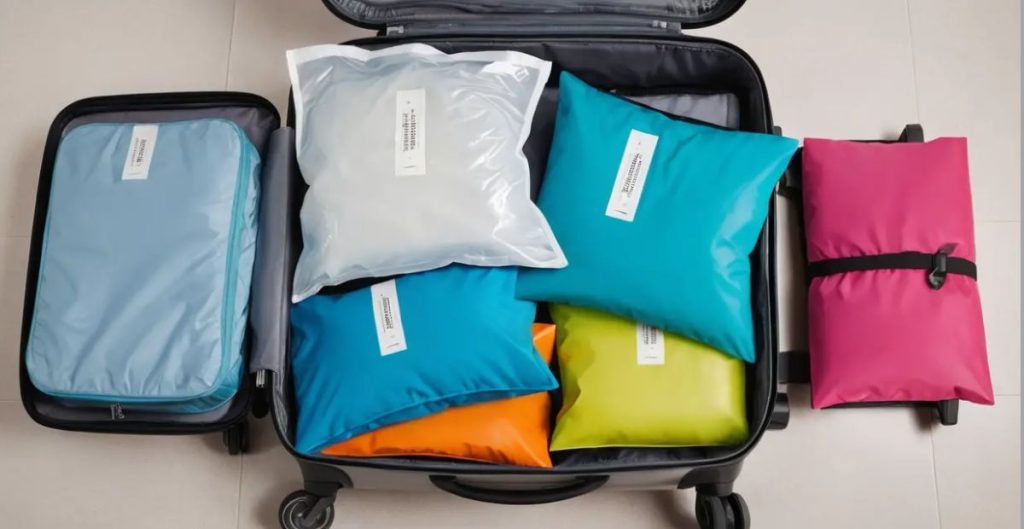
Frequently Ask Question About how do compression packing bags work
Do compression bags wrinkle clothes?
Yes, compression bags do wriggle clothes quite a lot if they are stuffed very tightly. Absence of air and pressure can cause creasing. You can also fold clothes so that they will not crease as easily, or pack less easily wrinkled fabrics. Plus, take stuff out of the bags soon after it arrives or at least after a little travel time to try to minimize wrinkles.
Can you use them in carry-ons?
Yes, you can use compression bags in carry ons. They are especially handy when it comes to space-saving in non-expansive baggage. Just remember airlines have rules for bag size and weight. Just make sure the bags you pick are airline compliant in terms of carry-on dimensions, and I recommend using manual compression bags as they do not require vacuum to compress and can be easily packed inside your carry-on without needing more equipment.
Are they suitable for all types of clothes?
Compression bags can hold most types of clothes, but they work best with strong, non-fragile fabric. Great for big items such as jackets, sweaters, and bedding On the other hand, fabrics like silk or lace, could be prone to wrinkling or damage from compression. You should not pack these items in a compressed manner, or at least you have to be extra careful when packing them, so that they can retain their shape inside the suitcase.
Conclusion
Compression packing bags are an absolute game changer for your packing game, especially if you’ve ever struggled with overpacking or fighting for a bit of organization. They help you conserve space, and organize all of your gear, while also preventing wrinkles, making them the perfect companion for any kind of traveler, whether you’re a world traveler or a novice.
Before you head off on your next adventure, I urge you to give compression packing bags a go. You may just be surprised at how easily they make the method of dealing with your luggage and how much you can fit your suitcase.
Knowing how do compression packing bags work, you will be traveling with a lot of ease and relaxation. Happy travels!

